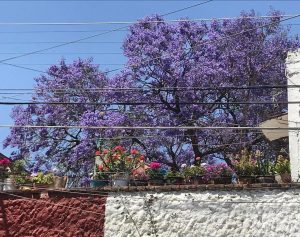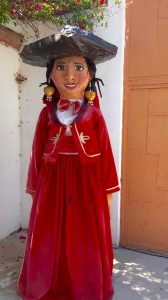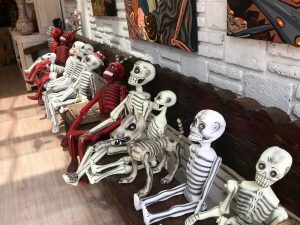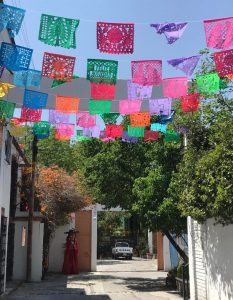Always near the top of my morning thank-you-for-my-many-blessings itemized prayer list is this item: “Thank you for legs that walk and eyes that see.” The two go hand in hand for me.
Living as I do as a retiree here in San Miguel de Allende, Mexico, a beautiful, centuries-old, largely pedestrian city, and not having (or needing) a car, my legs provide both transportation and recreation for me. And on my daily miles-long walks I make a point of stopping frequently to see.
There’s so much to see.
This week, for example, I’m seeing that the purple-flowered jacaranda trees are beginning to bloom. These grand, glorious trees, majestic as old oaks, are often halfway hidden behind tall walls. This was my first sighting this year:
And, despite the awful, ongoing coronavirus pandemic, I see uplifting whimsy wherever I look, such as the giant-size papier-mâché mojigangas (puppets) that stand like friendly sentries at some entryways:
Or these refugees from last November’s Day of the Dead celebrations, sitting on a pew-like bench as if listening to a Sunday sermon:
Or this canopy of festive flags along an alleyway, some still spelling “Feliz Navidad” (Merry Christmas) if you look closely:
As I’ve written before here, beauty is everywhere in San Miguel, if your eyes are open to it, if you stop (NB: admiring the sights while walking on the uneven pavement or cobblestone streets is likely to invite a fall) and look and really see. While other world-class cities are associated with beauty and art, San Miguel, as one writer put it, IS art.
But, truly, beauty and art can be found wherever we are in the world, even if we’re house-bound, as long as we use the gifts of our senses – as well as some imagination.
~ ~ ~ ~ ~
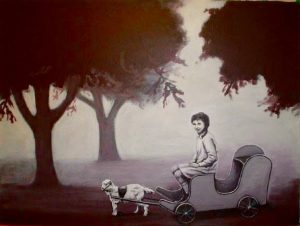
This week I had the honor of having my short fiction piece, “Angelina,” inspired by the above painting, “The Traveler,” by Sante Fe artist Anne O’Sullivan Winkler, published in The Ekphrastic Review, an online journal out of Toronto, Canada, devoted entirely to writing inspired by visual art.
According to Lorrette Luzajic, editor and founder of The Ekphrastic Review, “Our objective is to promote ekphrastic writing, promote art appreciation, and experience how the two strengthen each other and bring enrichment to every facet of life. We want to inspire more ekphrastic writing and promote the best in ekphrasis far and wide.”
While the term “ekphrasis” may be a relatively new entry in the Merriam Webster dictionary (“a literary description of or commentary on a visual work of art”) the practice is actually ancient, dating back to The Iliad. It’s no surprise, then, that the term ekphrasis derives from Greek, where it literally means “description.”
Anne’s painting “The Traveler” evoked for me a story of what might have been, a life I might have lived if things had turned out quite differently. I named the little girl in the goat cart Angelina. This is how my imagination made Angelina come alive for me (reprinted from The Ekphrastic Review):
Angelina
Of all the men I might have married, the one that stands out for me most clearly at this moment is the Italian tourist who asked me for a kiss as we stood waiting for the light to change on the corner of Madison and I-forget-what-street on the Upper East Side that summer afternoon in 1980.
Of course, I kissed him. I was like that then – accustomed to the admiration of men in New York, and accommodating when I was in the mood.
This man, a young-and-darkly-handsome Italian, with his broad smile and thickly accented English, put me in the mood for a street-corner kiss. But soon enough the light changed, and I went on my way to wherever I was in a rush to get to, blithely waving to him over my left shoulder and calling out one of the few words I knew in Italian: “Ciao!”
I’ve often wondered since: What if I’d lingered, walked with him to wherever he was going, maybe fallen in love and returned with him to Italy? I know this is a leap, but what if this Giuseppe – or whatever his lovely name was – and I had married and had a half-dozen Italian babies who tried their best to teach me, in turn, the intricacies of their musical language?
I have vivid imaginary memories of our summers together at Giuseppe’s family’s ancient farm in Tuscany. One memory in particular is of our daughter Angelina – the child who was most like me – hitching up a little goat to an old cart and announcing she was running away from home. We all stood in the driveway, waved goodbye and sang in a chorus, “Ciao!”pretending to be sad. She waved back. But the goat didn’t take her far.
Giuseppe’s mother, forever stooped and dressed in widow’s black, never grew to accept me. And her only son, my charming, errant husband, never stopped kissing beautiful young strangers on city street corners.
Yet I’ve never for one moment ever regretted our own street-corner kiss. Without that spark, there would never have been an Angelina.
~ ~ ~ ~ ~ ~ ~ ~ ~
For more about The Ekphrastic Review, or to see “Angelina” there, go to:
For previous WOW posts on the subject of ekphrasis, go to:
www.blog.bonnieleeblack.com/the-alchemy-of-ekphrasis/
and
www.blog.bonnieleeblack.com/farmette/
And for a previous WOW post on the subject of jacarandas, go to:
www.blog.bonnieleeblack.com/jacaranda-time/

